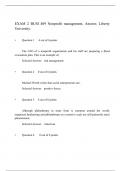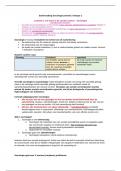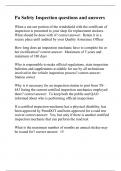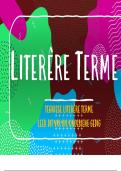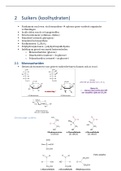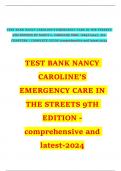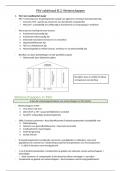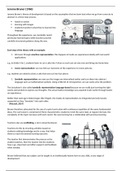Consumer psychology
1 Introduction
1.1 Me
“I study how individuals use and experience ICT and how these insights can be applied for persuasive
communication (advertising, health promotion, crisis communication, consumer protection and empowerment).”
- Digital game experience (dimensions, methods, involvement)
- In-game advertising (e.g. attitudes, interaction with game xp)
- Online consumer behavior
- Advertising on social networking sites (personalization, adolescents)
- Advertising in online news media (native advertising)
o Native advertising = advertising in the style and feel of the medium
There is a problem for news media when they use too much native advertising
Adblockers are a big problem for news media. They live from advertising revenue
(reclameinkomsten). When adblockers block their revenues from ads on their
website, they have to search an alternative format. This is why they choose native
advertising.
These articles don’t really look like ads, but if readers don’t recognize those
articles as advertisements, it can impose a danger on all journalistic values that all
quality newspapers must have (e.g. independent, being a watchdog, …)
- Persuasive technologies (serious games, reflective interfaces)
o Serous game = a game that is developed to be a fun game but with the main goal to learn
people something specific, influence their attitudes, …
Recently they developed a game to tackle cyber bullying. The game did have some
positive effects on attitude/… towards cyber bullying.
- Chatbots for marketingcommunication
o Chatsbots are being used more and more by companies (e.g. customer service)
o When you talk to a chatbot, they will retarget you one day later for other marketing
purposes. E.g. ‘you booked this, why don’t you go eat there’
- Big data, big deal?
o What does de general public knows about big data? Do they see it as a kind of big brother
thing, do they trust it, … ?
- Smart cities = some kind of umbrella term for everything that happen in cities that is connected
through sensors
o Maybe: when there is no one on the street, the lights don’t have to shine
o In Antwerp they know who is a first visitor, a repeated visitor, a visitor from abroad, a
visitor who only goes to the Meir, a visitor who also goes to the other streets, …
1.2 Strategic Communication
- CM = communication management → general course, what is strategic communication,
what can organizations do to position themselves, corporate level
- CP = consumer psychology → more theoretical, theory, based on scientific studies, scientific and
psychological insights in consumer behavior and information processing, (mainly) experimental
research – applied in various professional fields
- EffOZ = effectiviteitsonderzoek → in depth study of advertising + how to evaluate the
effectiveness, and whether the advertising objects were met – link with practice/business
- Persuasive Technologies (new course!)
o How can we use technological tools to steer/influence/change behavior?
o E.g. apps, serious games, VR, chatbots, …
o Link with theories of behavioral change and human-computer interaction
1
,o Collaboration with students from computer science
2
,1.3 Consumer psychology
What comes to your mind?
- Callers psychology
- Music in a store, type of music, color of the walls, greenery in the store or not, store is crowded or
not, store is tidy or not, … = store atmospherics
o How does the environment influence the behavior?
- Involvement
o If you are involved with a particular product, will you react differently than when
you are not involved with that product?
o E.g. you are very involved with sneakers and there appears an add on your Facebook
newsfeed about sneakers. Will you buy it more or click more on the add than someone
that is not involved/interested in sneakers?
We gaan winkelen. Voor elk product moet je een keuze maken tussen de verschillende merken die in de
winkel liggen, hoe ga je deze keuze maken als consument. Kiezen kan ook vermoeiend zijn. Wanneer je
moe bent, en je hebt meer en meer gekozen in de supermarkt, dan ben je op het einde meer kwetsbaar als
consument. Op dat moment ga je je keuzes baseren op irrationele motivaties, bv. iets kopen dat je niet
nodig hebt, maar dat er wel mooi uitziet. Daarom zetten ze op het einde allemaal snoep in de
winkelrekken.
- First picture. How can we study temptations? How people deal with they call vices (bad products:
chocolate) versus virtues (good products: raisins)?
- Fifth picture. Bikini campaign of H&M. How do we react to those types of ads? What does this
trigger in female brains versus male brains?
Last week, the new food triangle has launched. It gives the public advices on what products you must
consume and what products you have to avoid. What is on the top of the triangle they think is the best. In
the old food triangle, what was on the top, was what people had to avoid. So that’s why they flipped the
triangle.
- All activities that relate to people as consumers
- What makes the like/choose/buy?
o Emotions, rational behavior, choice processes, situational influences (how does the
situation in which you are has a very important impact on how you will react to an ad or
how you will behave?),
…
- How do consumers deal with persuasion attempts?
o Influence, resistance, young consumers, …
o Not only: how people are influenced, but also: how people can resist persuasion, how
they could cope with it.
- Psychological methods (experiments), focus on (underlying) processes of behavior (and
individual differences
o Underlying processes → explanations
o Individual differences: a behavior does not occur with every individual, what type of
personality explains why what kind of people respond in that way and others in that
way
3
, - Applies psychological theories to understand consumers and consumer behavior (CB)
- Core themes
o Consumer information processing (attention, elaboration, decision making)
o Motivation and affect
o Persuasion, attitudes, social influence
- Not only for academic and managerial purposes, goal is also to advance
knowledge for consumer wellbeing (+ public policy)
- Sub-division of the American Psychological Association (division 23)
- Related disciplines (Media psychology, Social psychology, Environmental psychology)
- Society for Consumer Research
- Website: http://www.myscp.rog/
1.3.1 Consumer information processing
- How do they process (consumer-related) stimuli?
- There is an Information overload these days (home, media, shops, other people)
- How does this affect their attitudes, and behavior?
This is the oldest model of consumer information processing. What was
thought: people are exposed to all kind of thing → some things grab their
attention → then they have to compresence → then they have to accept it
→ and than the can retention it
But this is a small part of what happened. This linear model only happens in
very rare situations. In most of the situations today, nothing has gone
through this pad. That is why we now know that this type of processing is a
cognitive one. It focusses on rational thinking.
This is only the tip of the iceberg. Everything that happens → at the bottom of the iceberg
Scientist have discoverd that Cognitive resources are limited!
- Physical muscles are also limited: you can’t run a whole day
- Mental muscle
- Depletion (uitgeput): the more your mental muscle get depleted, the more you
rely on mental shortcuts
- Mental shortcuts
You don’t always use the cognitive path. The cognitive path is limited.
1.3.2 Mere exposure effect
- Zajonc (1980): preferences need no inferences
o More and more models and studies gave insights in the unconscious brain, in the irrational
part of the brain, the respond automatically (het automatisch reageren).
o Zajonc is a very important name. He is one of the most important researchers in terms of
emotions. He discovered that the emotional part of our brain has an influence on our
choices.
- Showed “Chinese signs”
o People did like the signs that they saw more better.
- Tachistoscopy (subconscious)
- Repeated exposure leads to liking
- Applied to advertising (Janiszewski, 1983): incidental processing
4



